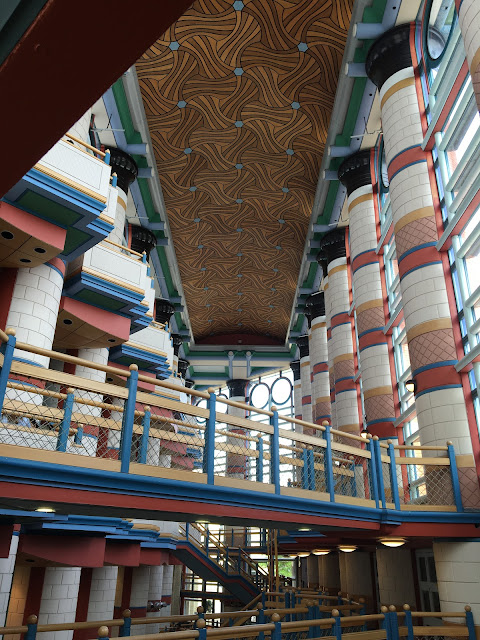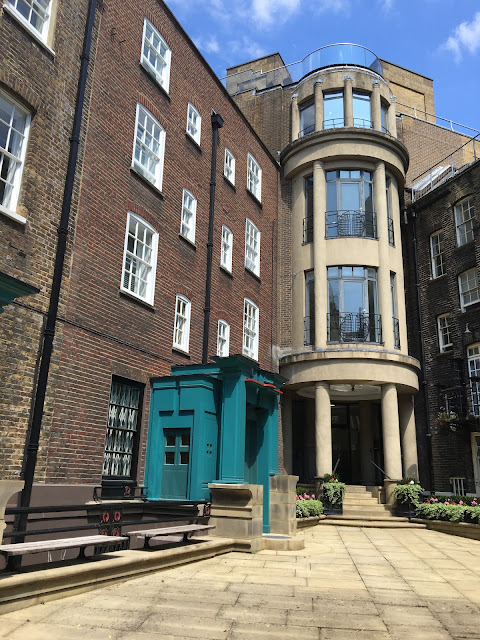Cambridge Tuesday, and my friend Penny - as bold as you like - and an unexpected visit to the Judge Business School on Trumpington St. And what an extraordinary, exuberant building this is. A marriage of former Victorian hospital and riotous Post-Modernism. The architect of the former Matthew Digby Wyatt and of the latter the maverick British architect John Outram (1934-). I feel I should apologise for the use of the 'M' word here, but what other could I use? Outsider? Both are some utility here, and yet neither are entirely satisfactory. Outram is perhaps an architect cast in a very British mould. 'A great individualist,' to use a phrase of Sir John Betjeman, and that takes courage. Especially when architectural education is aimed at compliance and uniformity. He is perhaps like one of those 'Rogue Architects' of the Gothic Revival, there is, after all, a large element of 'Structural Polychromy' in Outram's work. One feels that he has read and absorbed any number of theorists - Ruskin, I suspect, and French writers such as Blondel and Perrault. To hear him talk is to realise he is very widely read. His knowledge esoteric and arcane, and his buildings are freighted with a deeply personal and elaborate symbolism. As one critic has remarked he is that rare thing among contemporary British architects: a theorist. All a long way from the materialist culture of Modernism.
At the centre of the Outram's scheme is an immense trapezoid atrium - 'The Gallery' - linking the original building to a series of additional structures also by Outram. It is a complex space, with stairs leaping from one side to another, not that easy to comprehend at first, but clarity comes as you ascend. (A bit clunky these details of stair and balcony btw.) It is essentially a Hypostyle Hall as one finds in an Ancient Egyptian temple such as Karnak; an evocation also of its derivative, the Vitruvian Egyptian Hall, and the 'Primitive Hut' of Abbe Laugier. It is also a sort of grove; a Sacred Grove, perhaps. It reminds me also, in its sublime verticality and ratio of void to solid, of a Gothic cathedral, which of course is just another sort of grove. A word about the solid, the columns, they are in fact hollow, the conduits for the services, electricity and such like. They have been termed the 'Sixth Order'; Outram, I believe, refers to them as the Robot Order - the 'Ordine Robotico'. They have black bell capitals and bare the most complex and stylish entablature. The entablature, according to Outram, is a sort of fictive raft, its cargo here is the painted ceiling. Some of the detailing seems influenced Louis Kahn, some of it by Josef Plechnik, like the balustrade to the roof garden.
In a lecture on YouTube which Outram gave back in the day at The Architectural Association he talks about the origin of architecture as a housing for, well, the gods and heroes (though he doesn't name them as such), and how over time these primordial structures have become buried (the 'Cataclysm of Domesticity') in the city: "What happens, you see, that these as it were perfect buildings which also have a very big scale, these perfect buildings they just show a little vestige, you know. This is just showing its face, everything else is covered....now you see the idea that you have these kind of jewel-like perfect buildings buried inside a sort of mass of pragmatic structures, runs through even into formal, formally ordered plans...." Indeed. I suppose that he was trying, in some sense, to recapture the Pre-Modern pragmatic City. The city as palimpsest. And in doing so invents for the site a mythic history, creating a modern structure that aspires to the primordial; a building that in some respects defies categorisation. And one that critics are yet to come to terms with.
Further Reading
'John Outram' Geraint Franklin, Historic England Publishing, 2022






































